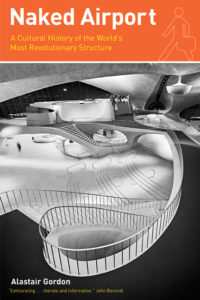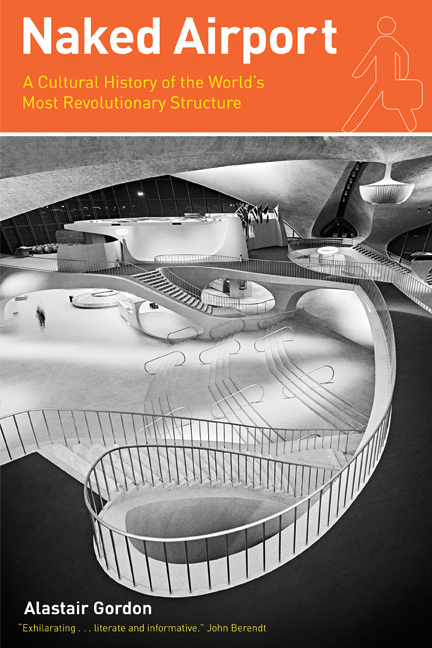Zaman zaman bahsettiğim Aerlines adlı e-zine’de havayolu sektörüyle ilgili bir çok makalenin yanı sıra, çeşitli kitapların değerlendirmeleri ve eleştirileri yayımlanıyor.
Bundan bir süre önce incelemiş olduğum “Naked Airport” adlı kitabın küçük bir gözden geçirmesini ilgili kişiye göndermiştim.
Aradan iki – üç ay geçtikten sonra kitapla ilgili olarak hazırladığım metni web sitelerinde nihayet yayımlamışlar.
Buradan dokumanın pdf formatındaki haline ulaşmanız mümkün.
Naked Airport, havalimanlarının tarihsel gelişimini yakından incelemek isteyenlere rahatlıkla tavsiye edebileceğim bir kitap.

İşte Naked Airport hakkında yazmış olduğum değerlendirme yazısı:
Naked Airport
A Cultural History of the World’s Most Revolutionary Structure
When people talk about commercial aviation, they usually talk about airline companies, aircraft and flight attendants. It is apparently far more attractive to talk about the airlines’ fiscal performances, the latest aircraft types, or the flight attendants’ outfits than about other aspects of the airline industry.
Airports, however, are sometimes overlooked in this respect, but as the final stops for passengers prior to boarding the aircraft, and, more in general, as gateways to air travel, airports play a very important role in terms of their facilities and the soothing atmosphere terminal buildings exude. The “Naked Airport” is probably one of the rare books covering the historical development stages of airport construction.
By Alastair Gordon
Book Review by: Abdullah Nergiz
Outline
The book covers the evolution of airport terminal construction in six chapters; from the muddy fields to the sterile concourse. The first three chapters include the prewar days (Prototypes: 1924-1930, Naked airport: 1930-1940, New deal: 1933-1941), whereas the final three chapters (Air power: 1939-1957, Jet-land: 1957-1970, The sterile concourse: 1970-2000) explain the rapid growth of the commercial aviation industry, and the constant need for bigger terminal buildings in the second half of the 20th century.
The book ends with the epilogue title of ‘Lindbergh to Bin Laden’, which discusses the tragic change of the image of aviation from freedom to security concerns.
Discussion
The book title was chosen after the architect Le Corbusier’s description of airports where he claimed that the beauty of an airport is in the splendor of wide open spaces and nothing could compete with the airplane itself, and thus the only appropriate architecture was one that was practically invisible: just sky, grass, and concrete runways. In brief, an airport should be naked. In the early days of commercial aviation, airports were small, close to the downtown areas of the cities they belonged to, and sparsely populated. But after World War II, the introduction of the jet engine gave a tremendous boost, elevating air travel to new heights.
Passenger numbers grew tremendously, and thereby generating an even greater demand for even bigger airport buildings. In the 1960s, gigantic airports were built to accommodate the rapidly growing numbers of jet travel passengers. Airports became like satellite cities in urban planning, complete with their own police forces, health care systems, fi re departments, accommodation plants and entertainment facilities. However, in the turbulent 1970s, security concerns of air travel began to come to the forefront as airline hijackings were becoming more common. Security concerns replaced architectural and stylistic concerns of airport buildings. Electronically controlled areas, security codes, cast concrete and massive roofs converted terminals to a less inviting public place as the final stop prior to boarding. Finally, towards to the end of the 20th century, architects tried to combine the security and comfort concepts in an effort to enable air travelers to relax before they board the aircraft.
Conclusion
The author’s smooth writing style and the 108 well-chosen black & white illustrations make the book very easy to read. I recommend the book to anyone intending to explore airports, one of the most important elements of air travel other than aircraft, airline companies and cabin crew.
The best part of the book is the legendary Terminal 5, or TWA Flight Center, designed by famous Finnish-American architect Eero Saarinen. The TWA Flight Center is also the apogee of the airport architecture style. I suggest readers visiting Terminal 5 in JFK (New York), if they can. Currently used by JetBlue, TWA’s bird-like Terminal 5 can be seen in many movies, such as Steven Spielberg’s Catch Me, If You Can.
About the author
Alastair Gordon is a contributing editor to House & Garden and Dwell magazines. He writes regularly for the New York Times, and his articles have been published in Architectural Digest, Conde Nast Traveler, Vanity Fair, Town & Country, and The New York Observer. He is the author of several books, including Weekend Utopia and Beach Houses.
About the reviewer
Abdullah Nergiz is a qualified aviation expert working as coordinator for Turkish Airlines. He is specialized in e-commerce and history of commercial airline industry.
Book Information
Author: Alastair Gordon
Title: Naked Airport – A Cultural History of the World’s Most Revolutionary Structure
Publisher: Metropolitan Books, Henry Holt and Company, Ltd.
Publishing Date: 2004
ISBN: 0-8050-6518-0

